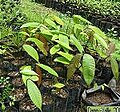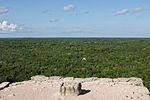Brosimum alicastrum, commonly known as breadnut, Maya nut or ramon, and many others, is a tree species in the family Moraceae of flowering plants, whose...
13 KB (1,573 words) - 06:37, 13 October 2024
Brosimum is a genus of plants in the family Moraceae, native to tropical regions of the Americas. The breadnut (B. alicastrum) was used by the Maya civilization...
5 KB (408 words) - 01:19, 29 July 2024
Brosimum guianense, called snakewood, letterwood, leopardwood, and amourette, is a species of flowering plant in the genus Brosimum, native to southern...
4 KB (215 words) - 17:42, 18 December 2022
The site of Ujuxte after the Ramón or Breadnut tree (Brosimum alicastrum)) is the largest Preclassic Maya site to be discovered on the Guatemalan Pacific...
4 KB (493 words) - 19:34, 8 October 2024
Brosimum utile (Kunth), also called Galactodendron, Pittier (= B. galactodendron) is a plant species in the family Moraceae. Brosimum utile can grow to...
9 KB (1,046 words) - 18:45, 23 August 2023
Israel Ramón tree, an alternative common name for the Breadnut tree (Brosimum alicastrum) Raymond Ramone (disambiguation) This disambiguation page lists articles...
6 KB (736 words) - 12:44, 29 December 2024
butter, flour or oil. Domesticated plants and animals of Austronesia Brosimum alicastrum, another plant also commonly known as "breadnut" "Artocarpus camansi...
8 KB (903 words) - 09:43, 9 November 2024
used as animal feed and to extract a popular edible oil. Breadnut (Brosimum alicastrum), used by the ancient Maya peoples as animal fodder, and as an alternative...
36 KB (3,607 words) - 16:27, 13 November 2024
forests is dominated by trees up to 30 m (98 ft) in height, including Brosimum alicastrum, Manilkara zapota, Celtis monoica, Bursera simaruba, Dendropanax...
11 KB (956 words) - 21:15, 3 November 2024
including Artocarpus, Bagassa guianensis, Brosimum alicastrum (breadnut) and others in the genus Brosimum, Caryocar (souari trees), Castilla elastica...
19 KB (2,059 words) - 15:32, 18 September 2024
simaruba, Cedrela odorata, Swietenia macrophylla, Spondias mombin, Brosimum alicastrum, Coccoloba barbadensis, Pithecellobium arboreum, Lysiloma divaricatum...
141 KB (16,386 words) - 01:41, 7 December 2024
and remained so through modern times. The Ramón or Breadnut tree (Brosimum alicastrum) was an occasional substitute for maize in producing flour. Fruit...
92 KB (10,159 words) - 10:18, 22 December 2024
other areas with greater moisture there are taller trees, including Brosimum alicastrum, Ceiba pentandra, and species of Ficus. Oak (Quercus) forests are...
5 KB (615 words) - 16:13, 10 February 2023
gerascanthus, and Lonchocarpus rugosus. Elsewhere Vitex gaumeri, Brosimum alicastrum, Caesalpinia gaumeri, Cedrela odorata, Ceiba pentandra, and Sideroxylon...
5 KB (475 words) - 10:19, 1 July 2023
were particularly effective for long-term storage of ramon nuts (Brosimum alicastrum). Associated with water, rain, and child sacrifice, chultunob' are...
3 KB (284 words) - 00:42, 12 September 2024
Manilkara zapota is the most common forest tree; others include Brosimum alicastrum, Pimenta dioica, Lonchocarpus castilloi, Pouteria campechiana, Swietenia...
7 KB (655 words) - 12:45, 2 September 2024
upland to the southwest are Apeiba tibourbou, Astronium graveolens, Brosimum alicastrum, Carapa guianensis, Cordia alliodora, Crescentia cujete, Croton niveus...
21 KB (2,289 words) - 10:48, 20 May 2024
organic matter. Species that predominate include Mayan breadnut (Brosimum alicastrum), sapodilla (Manilkara zapota), rosadillo (Celtis monoica), Bursera...
121 KB (14,235 words) - 17:54, 26 December 2024
trees of the lowlands, typically on limestone-derived soils, are Brosimum alicastrum, Sideroxylon persimile, Godmania aesculifolia, Manilkara zapota,...
5 KB (369 words) - 04:49, 23 May 2024
Mesoamerican period, especially roots, small chili peppers and a fruit (Brosimum alicastrum) as well as fish from lakes, rivers and ocean. The production of...
41 KB (5,381 words) - 20:55, 23 December 2024
The tree cover is composed of the following species: breadnut (Brosimum alicastrum), guanacaste (Enterolobium cyclocarpum), totoposte (Licania arbórea)...
50 KB (6,242 words) - 08:37, 25 October 2024
refer to: Artocarpus camansi, a close relative of the breadfruit Brosimum alicastrum, also known as "Maya nut" or ramón, theorized to be a staple crop...
534 bytes (76 words) - 14:52, 30 April 2023
(Platymiscium dimorphandrum), Mexican Cedar (Cedrela odorata), Breadnut (Brosimum alicastrum), Tamarind (Tamarindus indica) and Papaturria (Coccoloba montana)...
138 KB (16,434 words) - 01:19, 13 August 2024
Aspidosperma Astronium graveolens Bixa orellana Boehmeria Bridelia Brosimum alicastrum Bursera simaruba Butea monosperma Calamus caesius Calophyllum brasiliense...
9 KB (748 words) - 13:34, 22 January 2024
The site's name derives from the Mayan name of the ramon tree (Brosimum alicastrum), from the words ixim and che, meaning literally "maize tree". Iximche...
64 KB (8,070 words) - 16:24, 20 November 2024
Northern South America Small seeds imbedded in a hard core. Maya nut Brosimum alicastrum Yucatan and Guatemala to the Amazon Mexican calabash Crescentia alata...
124 KB (3,865 words) - 11:46, 24 November 2024
Philippe (November 2017). "Ancient Maya sylviculture of breadnut ( Brosimum alicastrum Sw.) and sapodilla ( Manilkara zapota (L.) P. Royen) at Naachtun...
8 KB (872 words) - 18:12, 7 December 2024
canopy trees include Alseis yucatanensis, Aspidosperma megalocarpon, Brosimum alicastrum, Calophyllum brasiliense, Dialium guianense, Erblichia odorata, Ficus...
9 KB (819 words) - 00:48, 30 June 2023
reaching a height of up to 30 m (98 ft), such as Mayan breadnut (Brosimum alicastrum), sapodilla (Manilkara zapota), rosadillo (Celtis monoica), Bursera...
21 KB (2,178 words) - 15:21, 22 November 2024
pedalai Moraceae (mulberry family) Brosimum: brosimum trees Brosimum alicastrum breadnut Moraceae (mulberry family) Brosimum gaudichaudii mama-cadela Moraceae...
186 KB (198 words) - 23:34, 6 December 2024



























